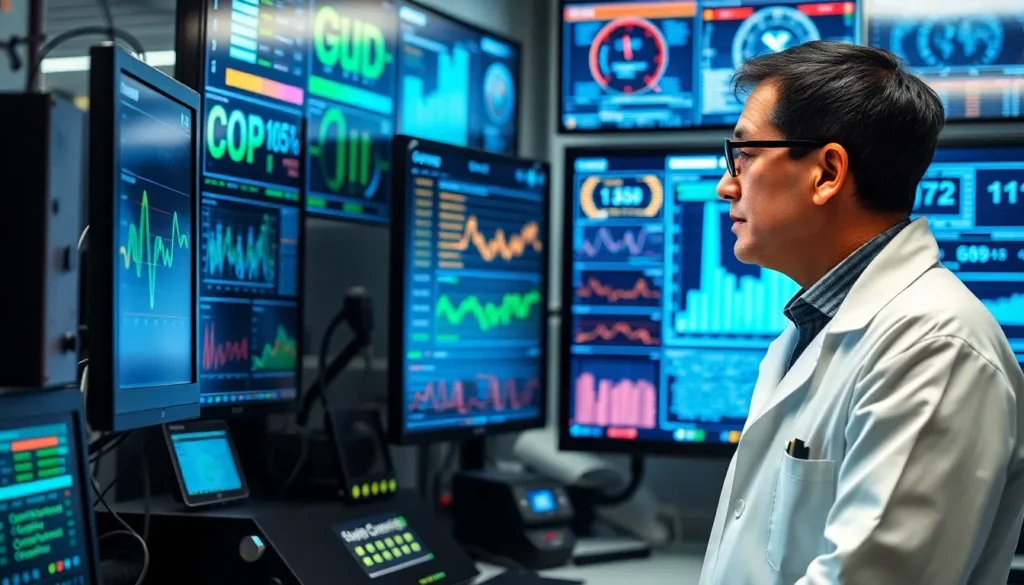In a world where attention spans are shorter than a cat video, visual edge technology is here to save the day. This innovative approach combines cutting-edge graphics with lightning-fast processing to deliver stunning visuals right where they’re needed most. Imagine a world where your devices can think faster than your brain can process—well, that’s not just a sci-fi dream anymore!
Visual Edge Technology
Visual edge technology presents a solution for addressing short attention spans prevalent in today’s fast-paced environment. This innovative approach combines cutting-edge graphics with swift processing to deliver captivating visuals.
Definition and Key Features
Visual edge technology defines a set of computing practices that prioritize visual data processing. Key features include real-time rendering, enhanced GPU capabilities, and ultra-low latency. It enhances user experience through seamless interactions with applications. This technology supports complex visual tasks, providing clarity and depth in graphical displays. Additional features encompass integration with AI algorithms to boost efficiency and visual fidelity.
Importance in Today’s Market
The importance of visual edge technology extends across various industries. Businesses increasingly adopt this technology to engage users effectively, addressing the challenge of shrinking attention spans. It facilitates quick decision-making by presenting critical information visually. Moreover, the demand for immersive experiences in gaming and virtual reality drives its market growth. Companies using this technology gain a competitive edge, attracting more users through enhanced visual appeal and functionality.
Applications of Visual Edge Technology

Visual edge technology finds applications across various industries, enhancing user interaction and operational efficiency. Engaged users experience improvements in data presentation and decision-making speed.
Industries Utilizing Visual Edge Technology
Healthcare benefits from visual edge technology through enhanced imaging systems and real-time analytics. Retail harnesses this technology for personalized shopping experiences and efficient inventory management. Education implements visual edge solutions to create interactive learning environments, engaging students more effectively. Manufacturing utilizes the technology to monitor equipment and improve productivity through real-time visual data. Entertainment sectors, particularly gaming and virtual reality, leverage these capabilities to create captivating experiences, attracting more users.
Case Studies Demonstrating Effectiveness
In healthcare, hospitals using visual edge technology have reported a 30% reduction in imaging processing times, enhancing patient care. Retail companies saw a 25% increase in customer engagement after integrating AR solutions for product visualization. In education, institutions adopting these technologies achieved improved test scores by 15% through immersive learning tools. Manufacturing firms that integrated visual edge technology reduced equipment downtime by 20%, increasing overall productivity. The gaming industry recorded significant revenue growth, with titles utilizing advanced visual rendering earning 40% more on average.
Advantages of Visual Edge Technology
Visual edge technology offers numerous benefits that enhance both user experiences and operational efficiencies. These advantages pertain to performance, cost-effectiveness, and resource management.
Enhanced Performance and Speed
Enhanced performance significantly impacts user experience. Devices leveraging visual edge technology exhibit real-time rendering capabilities that exceed traditional processing speeds. Increased GPU capabilities enable complex visual tasks without lag. Lower latency allows for immediate responses to user inputs, keeping interactions smooth and engaging. This rapid processing is crucial in sectors like healthcare, where imaging systems demonstrate up to a 30% reduction in processing times, thus improving workflow efficiency. Ultimately, quick decisions and seamless visualizations elevate user satisfaction across various applications.
Cost Efficiency and Resource Management
Cost efficiency serves as a critical advantage of visual edge technology. By optimizing resource allocation, businesses can realize significant savings. For instance, this technology reduces equipment downtime by about 20% in manufacturing settings. Such efficiency allows companies to allocate funds to other strategic initiatives, enhancing overall profitability. Personalized shopping experiences in retail further illustrate this, leading to a 25% increase in customer engagement while reducing inventory waste. Effective resource management becomes a reality when businesses adopt visual edge technology, showcasing its overall impact on bottom-line results.
Challenges and Limitations
Visual edge technology faces several challenges and limitations that impact its implementation and effectiveness in various industries.
Technical Challenges in Implementation
Integration of visual edge technology often requires significant upgrades to existing infrastructures. Many companies encounter compatibility issues with older systems, complicating the transition process. Scalability becomes a concern as businesses demand more processing power to handle real-time data. Additionally, managing the deployment of numerous devices while ensuring consistent performance poses technical hurdles. Employee training on new technologies can also slow down the adoption rate. As companies seek to implement these changes, balancing cost with technological advancement proves to be a relentless challenge.
Security Concerns and Data Privacy
Security remains a critical issue when adopting visual edge technology. Organizations face heightened risks of data breaches due to the increased connectivity of devices. Sensitive information processed in real-time raises significant data privacy concerns, requiring strict compliance with regulations. Implementing robust security measures becomes essential for safeguarding against potential threats. Consequently, maintaining user trust while leveraging cutting-edge technology complicates the balance between innovation and safety. Data management strategies must evolve to protect user information, ensuring businesses operate within legal and ethical standards.
Future Trends in Visual Edge Technology
Innovative developments continue to shape visual edge technology. Improved integration of artificial intelligence enhances data processing and visual fidelity. Companies increasingly focus on real-time applications, enabling seamless interactions. Advancements in graphics processing units (GPUs) drive faster rendering times and lower latency. Emerging platforms leverage edge computing to bring computations closer to devices, further enhancing the user experience. Applications for augmented reality and mixed reality are set to transform marketing and training environments.
Innovations on the Horizon
Predicted innovations include smarter algorithms that personalize user interactions. Expect a rise in holographic displays that provide immersive experiences. Ongoing research aims to enhance visual clarity in low-light environments. Collaborative tools will evolve to support remote teaming through advanced visualization techniques. Enhanced mobile applications will increasingly utilize edge technology to improve response times and interactivity. Future developments will focus on optimizing energy consumption, ensuring sustainable operations in various sectors.
Predictions for Market Growth
Visual edge technology is projected to grow significantly in the coming years. The market can expect a compound annual growth rate of 30% from 2023 to 2028, driven by high demand across industries. Adoption in healthcare alone could surge due to its efficiency in imaging systems, bolstered by a push for real-time analytics. Retailers are increasingly investing in personalized technologies, leading to a 25% average rise in customer engagement. Furthermore, the gaming industry anticipates a revenue increase of up to 40% as titles embrace advanced visual rendering techniques. Businesses utilizing this technology will gain a strategic edge in attracting users and enhancing profitability.
Conclusion
Visual edge technology is reshaping how industries interact with users and process visual data. Its ability to deliver real-time visuals with low latency not only enhances user experiences but also drives operational efficiencies. As businesses navigate the challenges of implementation and security, the potential for growth remains immense.
The ongoing advancements in AI and GPU capabilities promise even more impressive developments. Companies that embrace this technology will likely see a significant competitive advantage. With projections indicating a robust market expansion, visual edge technology is set to play a pivotal role in the future of various sectors.


More Stories
Partner with Experienced Shopify Plus Developers to Grow Your Store
Leading Benefits of Generative AI Consulting
Defining the Threat Shaking Business Continuity Worldwide